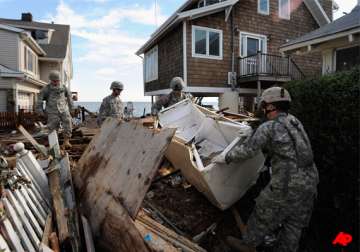Montpelier, August 30: Transportation was getting back to normal in most eastern states on Tuesday in the wake of Hurricane Irene, though some towns still grappled with flooding and many homes remained without electricity.
At least 46 people were reported killed by the storm, which blew through the Caribbean and up the U.S. eastern seaboard before hitting Canada.
In New York City, where people had braced for a disaster-movie scene of water swirling around skyscrapers, the subways and buses were up and running again in time for the Monday morning commute.
By Tuesday, a majority of riders on the hard-hit Long Island Rail Road and Metro-North Railroad were able to get onto trains to the centre of the city, although some Long Island communities still were without service because of flooded tracks.
To the north, landlocked Vermont contended with what its governor called the worst flooding in a century.
In many cases, the moment of maximum danger arrived well after the storm had passed, as rainwater made its way into rivers and streams and turned them into torrents.
Irene dumped up to 11 inches (28 centimetres) of rain on Vermont and more than 13 inches (33 centimetres) in parts of New York.
Some Amtrak service in the Northeast was limited or suspended, and airlines said it would be days before the thousands of passengers stranded by Irene find their way home.
The death toll for 11 eastern U.S. states rose to at least 40 as bodies were pulled from floodwaters and people were struck by falling trees or electrocuted by downed power lines.
A driver was missing after a road collapsed and swallowed two cars about 62 miles (100 kilometres) northeast of Montreal.
Irene also killed at least five people in the Dominican Republic and Haiti and one woman in Puerto Rico.
For many people, the aftermath could prove more painful than the storm itself.
In North Carolina, where Irene blew ashore along the Outer Banks on Saturday before heading to the north, some 1,000 people were still in emergency shelters, awaiting word on their homes.
At the same time, nearly 5 million homes and businesses in a dozen states were still without electricity, and utilities warned it might be a week or more before some people got their power back.
Early estimates put Irene's damage at $7 billion to $10 billion, much smaller than the impact of monster storms such as Hurricane Katrina, which did more than $100 billion in damage. Irene's effects are small compared to the overall U.S. economy, which produces about $14 trillion of goods and services every year. AP
Latest World News
